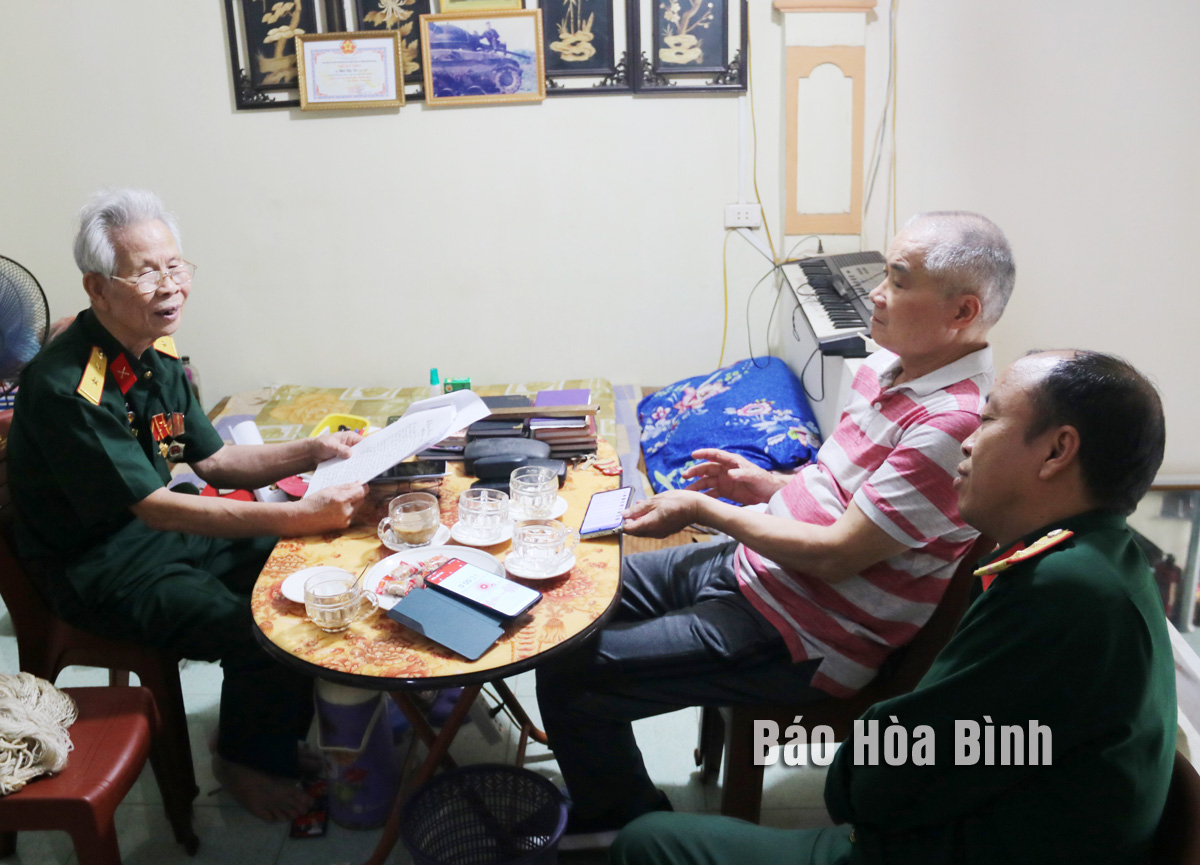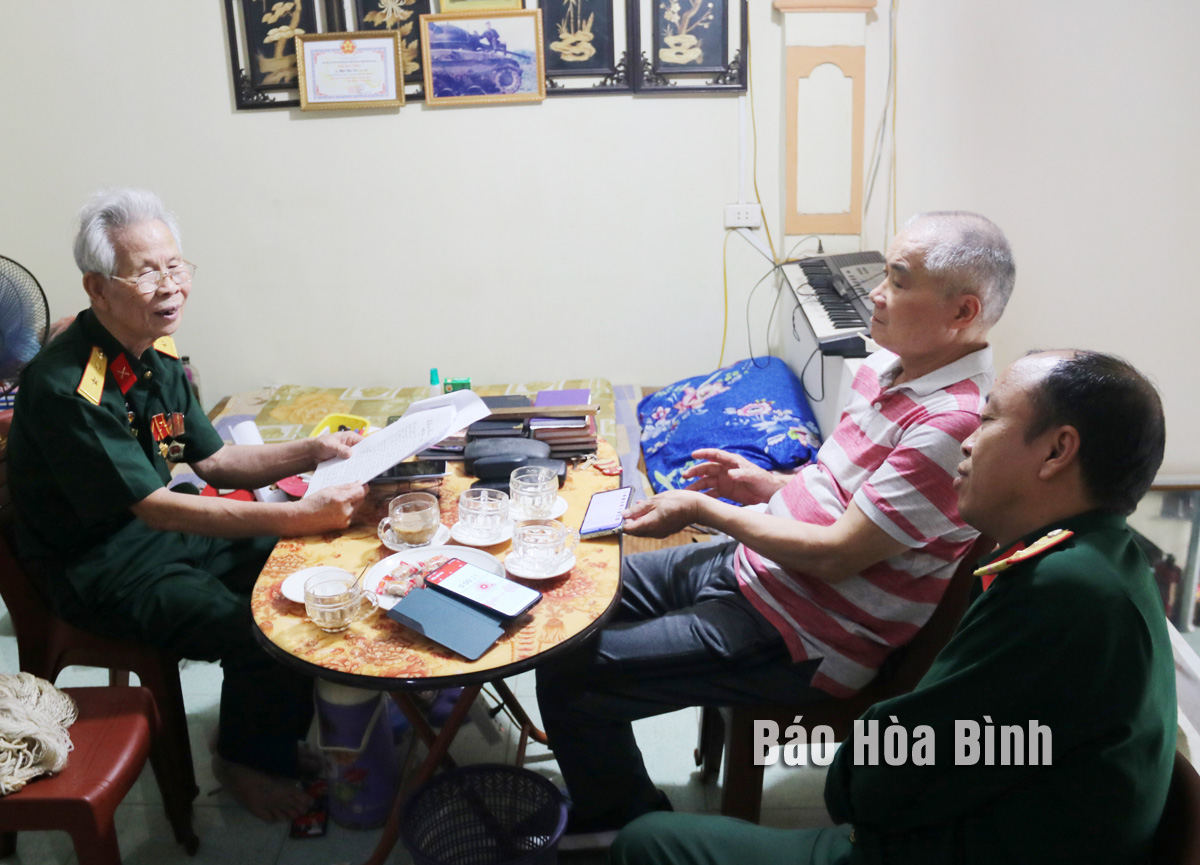
Despite the age of 90, Mai Dai Xa, a war veteran in Dong Tien ward of Hoa Binh city, still expressed enthusiasm whenever recalling the days he joined his comrades in the attack against Hill A1 during the Dien Bien Phu Campaign 70 years ago.
War veteran Mai Dai Xa in Dong Tien ward of Hoa Binh city recalls the fierce fight on Hill A1 seven decades ago.
joining the army at age of 18
The silver-haired man spoke in a strong voice and his eyes brightened when talking about the period full of hardships but also glory when he and his comrades took part in the fight on Hill A1.
Xa said that he was born and grew up in Hoang Hoa district, Thanh Hoa province in a family with three sons and all volunteered to join the army. He recalled that in 1952, he reached the age of 18. Though it was not mandatory for him to serve in the army because his brothers already did, he still followed his friends to go soldiering.
After fighting in Inter-region No 3, his unit – Regiment 174 under Brigade 316 – was sent to Dien Bien to join the Dien Bien Phu Campaign.
At the Dien Bien Phu battlefield, Regiment 174 coordinated with other military units to attack and destroy the French fortification at Hill A1.
Hill A1 was the fiercest front, where Vietnamese troops had to fight for the longest duration and suffered from the heaviest casualties, Xa recounted.
He noted that a number of his comrades laid down their lives in this combat. Every inch of advance on this hill during the 38-day combat cost the lives of numerous soldiers. To him, these are unforgettable memories.
Crushing Dien Bien Phu military base to secure victory
At that time, Xa was a reconnaissance soldier and performed duties in the frontline, so he was present in the fiercest battles. He said after 17 strenuous nights of digging trenches amid incessant rains in forest, exactly at 6:30pm on March 30, 1954, Regiment 174 opened fire on the enemy’s fortification on Hill A1. It was not until six hours later that Vietnamese troops, with great casualties, managed to take over three-fourths of this hill but then had to retreat to consolidate their force.
After the force was consolidated, Regiment 174 went on to wage another attack on Hill A1. This offensive was much more difficult and arduous than the previous ones. The trenches Vietnamese troops dug at night were refilled by the enemy in the morning. Due to the hard soil at the site, they could dig trenches of just over 1 metre in depth and 80 - 100cm in width. Incessant rains also resulted in mud everywhere, hampering Vietnamese troops’ mobility. Meanwhile, the enemy took strong defensive measures and used powerful fire, leading to heavy casualties for Vietnam, he added.
To deal with this fortification, Vietnamese troops decided to burst it inside out by putting 964kg of explosive inside the hill. At 8pm on May 6, 1954, when it exploded, soldiers from underground stormed onto the hill, smashing the strongest defensive fortification of French colonialists in Dien Bien Phu. This success contributed to the complete defeat of the Dien Bien Phu military base at 4pm the next day, making the globe-shaking victory after 56 days and nights of countless hardships, the war veteran went on.
After the Dien Bien Phu Campaign, Xa stayed in Dien Bien province to work at the province’s Radio and Television Station until his retirement in 1989 and later he moved to Hoa Binh province.
He said it was not until 10 years ago that he had a chance to return to the former battlefield and visit Hill A1 and the places his unit used to base at. There, he could see strong changes in Dien Bien, where people of all ethnic groups enjoyed better life quality. Although it is now hard for him to visit Dien Bien due to old age, he is still happy when learning about the province’s development via the media.
In the spirit of "Party members go first, the people follow”, all households of Party members in the Doan Ket sub-region in Da Bac town, Da Bac district, voluntarily removed gates and fences, and donated land when the road expansion project passed through their properties. Inspired by their example, 68 households in the sub-region quickly followed suit, contributing over 1,400 sq.m of residential and perennial cropland to widen the main road through the residential area. The exemplary role of Party members in Doan Ket stands as a shining example of studying and following President Ho Chi Minh’s thought, morality, and lifestyle.
The Hoa Binh provincial People's Committee held a monthly meeting on May 29 to assess the implementation of socio-economic development tasks in the first six months of 2025, the progress of key projects, and some other important issues.
During his lifetime, President Ho Chi Minh always expressed his deep affection and special concern for children and youth. He once emphasized: "Caring for and educating children well is the responsibility of the entire Party and the entire people”; "First of all, the family (i.e. grandparents, parents, siblings) must do this job well”. "the Party Committees…, the Children’s Committee, the Youth Union, the education sector, and all related organizations must have specific plans to ensure children grow healthier and more progressive”. His teachings has been remaining valuable and serving as the guiding principles in the work of protecting, caring for, and educating children. In line with this ideology, Hoa Binh Province has continuously been prioritizing and investing resources in the well-being of children in recent years.
Mr. Nguyen Phi Long, the alternate Member of the Party Central Committee and Secretary of the Provincial Party Committee chaired the meeting of the Standing Committee of the Provincial Party Committee to provide opinions on several investment projects within the province. There was the attendance of Ms. Bui Thi Minh, the Permanent Deputy Secretary of the Provincial Party Committee and Chairwoman of the Provincial People’s Council; Mr. Bui Đuc Hinh, the Deputy Secretary of the Provincial Party Committee and Chairman of the Provincial People’s Committee and other members of the Standing Committee; the leaders from other departments, agencies, and some localities.
The Standing Board of the Vietnam Fatherland Front (VFF) Committee of Hoa Binh province held a meeting on May 28 to honour outstanding village elders, village heads, and reputable individuals from local ethnic minority and religious communities.
In mid-May, the provincial Museum organised an exhibition named "Duoi la co Dang Cong san Viet Nam quang vinh” (Under the flag of the glorious Communist Party of Vietnam). This meaningful activity took place in the joyful atmosphere to celebrate the country's major holidays and the Party congresses at all levels for the 2025-2030 term, towards the 14th National Party Congress.



